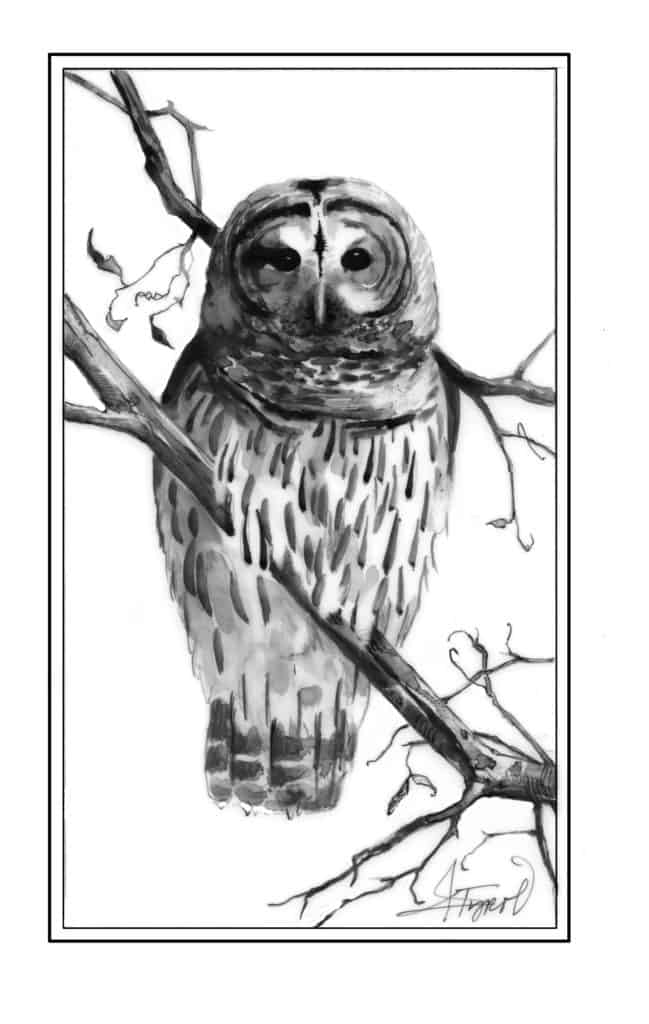
By Lee Emmons
On frigid winter evenings, the hooting of a barred owl (Strix varia) serves as a reminder that the darkened forests of the Northeast are still very much alive with activity. Owls’ nocturnal calling emanates from favorite forest haunts, including along lakeshores, swamps, and rivers. But the sound of an owl late at night also conveys a certain eeriness. Or perhaps we are simply conditioned to feel that way. Owls have generated feelings of awe, fascination, and fear for millennia, and their lives and sounds feature heavily in our collective imagination.
The classic “Birds of America,” edited by T. Gilbert Pearson, pays heed to the barred owl’s call, stating, “The volume and variety of these who, who call notes is one of the wonders of the wilderness and when two or three males get to discussing affairs together, the animation they inject into the melody is quite alarming to a timid person not accustomed to the sounds.” I suspect more than a few people have gotten goosebumps over the years listening to barred owls in the dark.
With a wingspan of about 40 inches, barred owls weigh from 2 ½ to 4 ½ pounds. They do not have ear tufts, and, unlike other owls our region, they have dark brown eyes. The owls’ streaked brown and white coloring allows them to blend into their natural surroundings. Their hooting call is often described as, “Who cooks for you? Who cooks for you-all?”
Barred owls are relatively common year-round residents of the eastern United States. They also live in parts of Canada, the Pacific Northwest, and even a few pockets in Mexico. A consumer of small reptiles, amphibians, and rodents, barred owls hunt primarily at night. Leaving the security of a high perch, barred owls swoop almost silently through forests and over wetlands in search of prey. Some even inhabit suburban areas that have an ample supply of mature woods.
Despite their tendency to be out at night, barred owls occasionally appear during daylight hours, too. Seeing these birds during a diurnal sojourn is a special treat. I remember looking up several years ago and spotting an owl sitting in a tree on a secluded ridge. On another occasion, I stumbled across a barred owl as it flew by my compost on a chilly March evening; my crunching footsteps across the packed snow clearly disturbed its hunting, and the bird took off for the safety of the trees.
My home in southern Maine is bordered by a swampy wooded area that contains numerous large trees, snags, and vast amounts of chipmunks, mice, and red squirrels. This is prime barred owl habitat. As the sun sets, the owls make their presence known. On plenty of occasions, I have listened to their hooting coming from the dark woods. I’ve also woken with a start to the screeching of the juvenile owls.
Not surprisingly, myths and stories about owls span cultures and continents. Athena, the Greek goddess of wisdom, was often accompanied by an owl, considered a symbol of wisdom. The Romans, however, believed owls to be witches masquerading in different form, and sometimes killed the birds and nailed them to doors. In ancient Rome, an owl’s call indicated that death was near. In contrast, in parts of modern-day Asia, owls are linked to good luck. In other places throughout history, they were also associated with fertility.
The Abenaki people of the northeastern woodlands have traditionally seen owls in a variety of different ways. Anne Jennison, a New Hampshire-based Native American storyteller, says that owls are “acknowledged as strong and with sharp eyesight, as good hunters, and as creatures of the night.” Jennison noted that owls are not identified by “one persona” to the Abenaki; they are portrayed as wise in some stories, but not in others. Jennison also shared that owl sounds “would have been very familiar to our ancestors.”
Owls have lived alongside people in the world’s forests for several thousand years. Their nightly calling has inspired myriad legends and reactions from various cultures. It sets the scene in horror movies and scary stories. But on a cold, mid-winter night in New England, a barred owl’s hoot is a welcome after-hours sound. To me, it is a reminder that life in the forest carries on after we go to bed. And perhaps, on a primal level, the hooting of an owl also represents our fascination with the dark and the animals that call it home.
Lee Emmons is a nature writer, public speaker, and educator. The illustration for this column is by Adelaide Murphy Tyrol. The Outside Story is assigned and edited by Northern Woodlands magazine and sponsored by the Wellborn Ecology Fund of the New Hampshire Charitable Foundation: nhcf.org.




